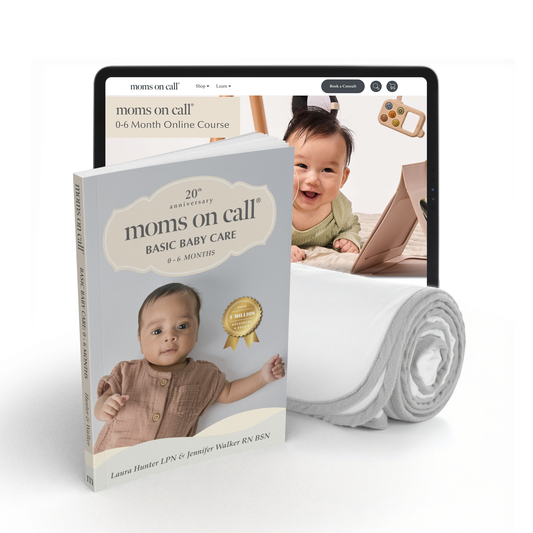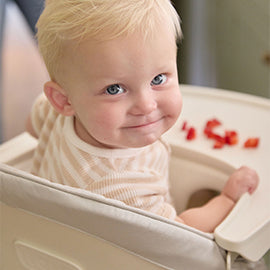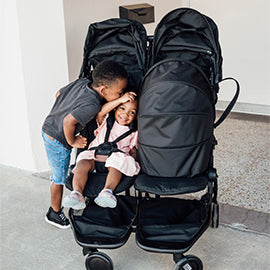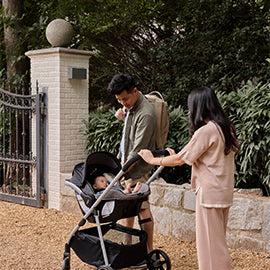When our son was an infant, my husband and I got into the habit of calling him a potato. We called him that in the absolute most loving way possible, of course, but you know what I mean - they just sit or roll like a potato in those early months! I will never forget the time we were in our neighborhood pool over the summer and we had just purchased a little raft for our son. My husband and I were commenting and chuckling throughout our time in the pool about how he was in “full potato mode,” expressionless, but taking everything in. There happened to be a little boy in the pool who was fascinated with the baby and listening to us talk. All of the sudden he asked, “Wait, is his name Potato???” This just cracked us up!
I share this story because this article focuses on the role of music for the 6-15 month age range (for more information on music and 0-6 month old babies, click here). Being at the tail end of it now with my soon-to-be 15 month old son, I can look back and really remember this time as our potato turning into a french fry (sometimes with some added salt!).
There is SO much happening developmentally throughout these months and those personalities really begin to shine. Because of the plethora of things occurring throughout this age range (i.e. crawling, potentially walking, intentional movements such as clapping and waving, an explosion of receptive language skills, first words, eating solids, changing nap schedules, etc.), our goal is to provide you with a few songs that can grow with your child.
Singing “If You’re Happy and You Know It” to my son at 6 months old is now an entirely different experience at 14 months. During the potato phase, he would just sit and watch me, but now, he smiles and does the motions right along with me! I think that’s been one of the most amazing things to witness these last several months as a first time parent. Babies spend months and months just watching, absorbing, learning and then all of the sudden….they join right in!
Music and Skill Development
I have always been in awe of how many different developmental skills can be cultivated through engaging a child in music. Music is actually one of the only activities that incorporates both sides of the brain.
Motor, Communication and Cognitive Skills
I don’t know about any other parents out there, but when my son waved and clapped purposefully for the first time, I think my voice jumped about 3 octaves saying “Oh my gosh! He waved at me!!!”
There’s nothing like those first moments of purposeful, joint interaction. Music is the perfect tool to practice these skills and reinforce the vocabulary that goes along with them. With this age range, seated movement is going to be the primary way to practice these motor skills.
Here are some ideas and considerations for using music to practice these important developmental skills:
- Model Music:
- I cannot stress this enough. Your child watches you like a hawk! The more they see you do the motions you are singing about, the better!
- Handheld instruments:
- Start to use or create songs that have instructions such as “shake up high,” “tap the drum,” or “shake to the side”
- (Note: You do not have to buy instruments to engage in music in your home. An empty water bottle with some Cheerios in it makes for a great shaker or a bowl from your kitchen cabinet can be a wonderful drum.).
- Start to use or create songs that have instructions such as “shake up high,” “tap the drum,” or “shake to the side”
- Hand over hand:
- Gently place your hands over your baby’s hands or feet and help them with what it feels like to clap or stomp when prompted in a song.
- I personally only like to do this the first or second time I’m introducing an action before moving to modeling and letting them try in their own time.
- Receptive language just blossoms during this 6-15 month age range. Every time you sing a word and do the action or show them the matching body part, you are reinforcing language. However, songs with too many words can create confusion.
- Think about singing songs with your child that are simple and repetitive.
- Songs that give multiple opportunities to practice the same skill are important. Trust me, I get it. It’s not thrilling for us parents to sing 10 rounds of “Wheels on the Bus,” but repetition leads to comprehension (and it’s fun to get creative with what is on the bus!).
Interactive Songs for Busy Babies and Toddlers: A Parent's Guide from Metro Music Makers on Vimeo.
Song Example - “Bluesy Hello”
- This song provides an opportunity to practice waving, clapping, stomping and can be customized with additional movements. It also provides an opportunity to include the family and/or objects you may be saying hello to. My son loves waving to trees, mailboxes, the little neighborhood dog waste stations, everything!
Song Example - “Find It” - See video above for implementation ideas (Minute Marker: 2:08).
- Another fine motor skill that surfaces in this age range is pointing. This brief rhythmic chant (let’s be honest, I wanted to pretend I could rap) was designed to encourage pointing and object identification. After showing my son his ball and saying the word so many times, when I said “Where’s your ball?” for the first time and he went to get it was magical. This can be used with body parts or objects in your environment.
Music to Cue Daily Activities
All of the tips shared in the 0-6 month old blog about incorporating music into your day still ring true. However now at 6-15 months, your child can really begin to understand the repetition of daily activities. I previously shared a lullaby created to help in your bedtime routine.
A few benefits of using songs for other daily activities are as follows:
- Reinforces the steps of a certain activity
- For example: Cleaning up, washing hands, and sitting in a high chair to prepare for a meal.
- Serves as a timer and/or transition
- A clean-up song where everything needs to be put away by the end of the song
- Teaches and reinforces language
- Provides predictability and structure
Song Example - “Oh Baby! Guess What?” - Get your little one ready for breakfast, lunch, dinner or snack! In the video above (Minute Marker 3:12), I share the song seated with my son. You can easily sing it while you are actively washing hands, getting into the chair, etc.
If you have a little tater tot in this 6-15 month old age range, I encourage you to try playing music in the background throughout your day, have daily dance parties, try using a song as a way to transition from activity to activity and take a few minutes to practice a skill through a song! Stay tuned for our next blog sharing musical tips for children ages 15 months - 4 years!
“Bluesy Hello,” “Find It” and “Oh Baby! Guess What?” are available for streaming on all digital music platforms here.

For more information about music lessons, music therapy, or customized song options for your little one at Metro Music Makers, please visit www.metromusicmakers.com.
























